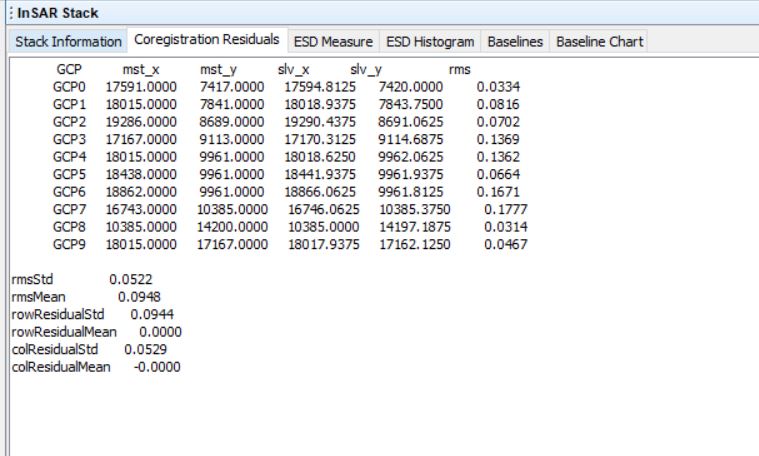the first image is probably a different track / relative orbit. I would leave it out and try again.
i’m trying again changing the initial offset method to Product geolocation , but it takes 20 minutes for each image to elaborate.
if you selected the first product form the screenshot as master image, it is likely to fail.
So I would recommend to try again with “orbit” as offset method with a different master image.
i found the master image with the InSAR stack overview. its not the first one, but the 30SEP2012 . but i’ll try again taking out the forst image that is not in the same track
So I did as you said, and this time I think I had better results. anyway, there is something strange about it. i checked the accuracy of the co-registration by using the RGB representation, but there is nothing there than black window. so i tried the InSAR Stack tool and this is the result.
have you tried opening the single rasters instead of an RGB? Are you sure that they are empty?
when i open the intensity from the band folder , i can see the black and white pixels. its only the RGB that doesnt seems to work. So, you think the coregistration residuals data is right?
Please check all bands individually to go sure. Sometimes only the first product is correct after coregistration and the others are many empty (although your residuals indicate correct processing).
I checked avery raster, and they all do have information inside. so I think this can do well. thank you for your help
yes, you can then proceed :+1
Hello. I might have another problem. after co-registration i’m trying to do the interferometric formation. I left the predefined parameters, and clicked run. after hours ( very much hours),I don’t think the process finish well. I tried again changing something, but the result is the same.
First, there is no new product in the product explorer window ( after the process, usually a new product is created).
Secondly, it does not show the time it took to process(in red, in the run window).
Thirdly, when I click in the Bands to se the coherence ( or the phase), what i see is only a rectangle image and not a square ( as the first image is a square).
After this I noticed a red stop sign at the right bottom of the snap window, and this is what it shows:
have you tried to make a subset after coregistration (rather small, just for a test) and run the interferogram generation again?
I wonder if it is a matter of computing capacities or a data processing error.
i’ll give it a try. I have to process the whole image, that’s why I haven’t considered the subset
you were right. my pc couldn’t handle all that process. i tried to subset it, and it works perfectly. so you think, it’s better to work on different subset ?
alright. Just limit the size of the stack as much as possible.
There are also some settings to check for increased performance of SNAP - could be worth a try.
- S2 export into tiff - NaturalRGB or Falso color infrared RGB
- S1 TOPS Coregistration error - Java heap space error?
- Problem creating image from a band
For PS processing the stack should contain all dates at once so your only option is to limit the area and to increase processing power.
Hello! I have some questions related to this topic.
-
I have used DEM assisted coregistration with subset of CSK images. I selected a master (May 2017) and i made 2 coregistrations: “only year 2017” and “years 2016-2018” (with the same master). I obtained a different result for the same 2017 MM-slv couples? How could it occur?
-
I tried also to avoid subset, but I obtained a full-frame coregistrate with a shift (always by using the DEM assisted coregistration); the area has a lot of mountains; does it affect the DEM assisted coregistration or could effectively be used?
-
Is it possible to process 3 years of CSK images with the same master or it is necesary to process each single year?
Thanks in advance for the support
- What do you exactly mean by “a different result”?
- Strong topography is good for DEM based coregistration
- You can input all images for the coregistration at once and they will be coregistered to the master
- When I make the RGB composition (MM / SLV) for the 2 coregistrations (“only year 2017” and “years 2016-2018”) they seems different also if MM and SLV are the same
- Ok! Thank you. But what I have to change when I found a shift? Sometimes, also strange triangular artifacts affect the coregistrate
- Ok, but for CSK images what temporal range could you suggest to avoid decorrelation?
I suggest another input DEM then. Have you selected SRTM 1 ArcSec? You can also download (and mosaic) one yourself and check it for errors before you use it as an external DEM.
I have used both DEMs (SRTM 1 and 3 ArcSec).
By using an external DEM, Is it necessary to carry out any previous transformation?
Thank you for your help

